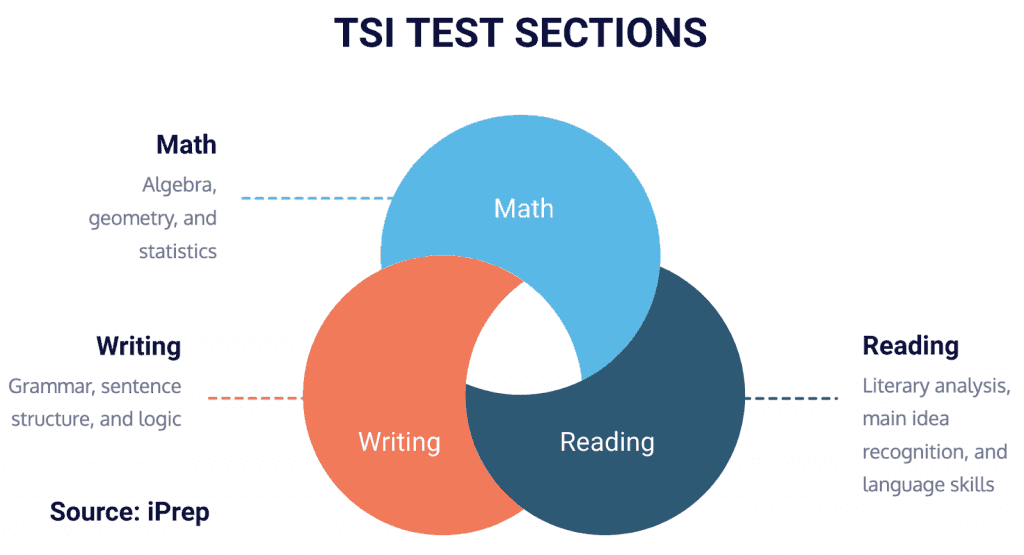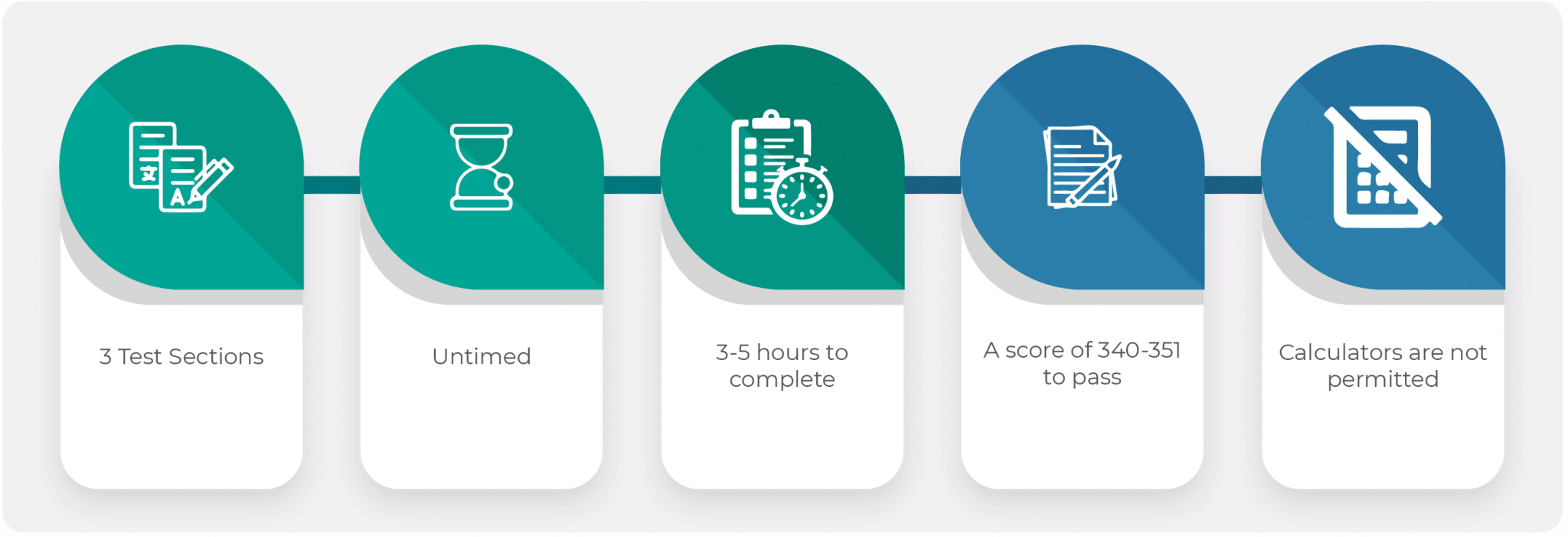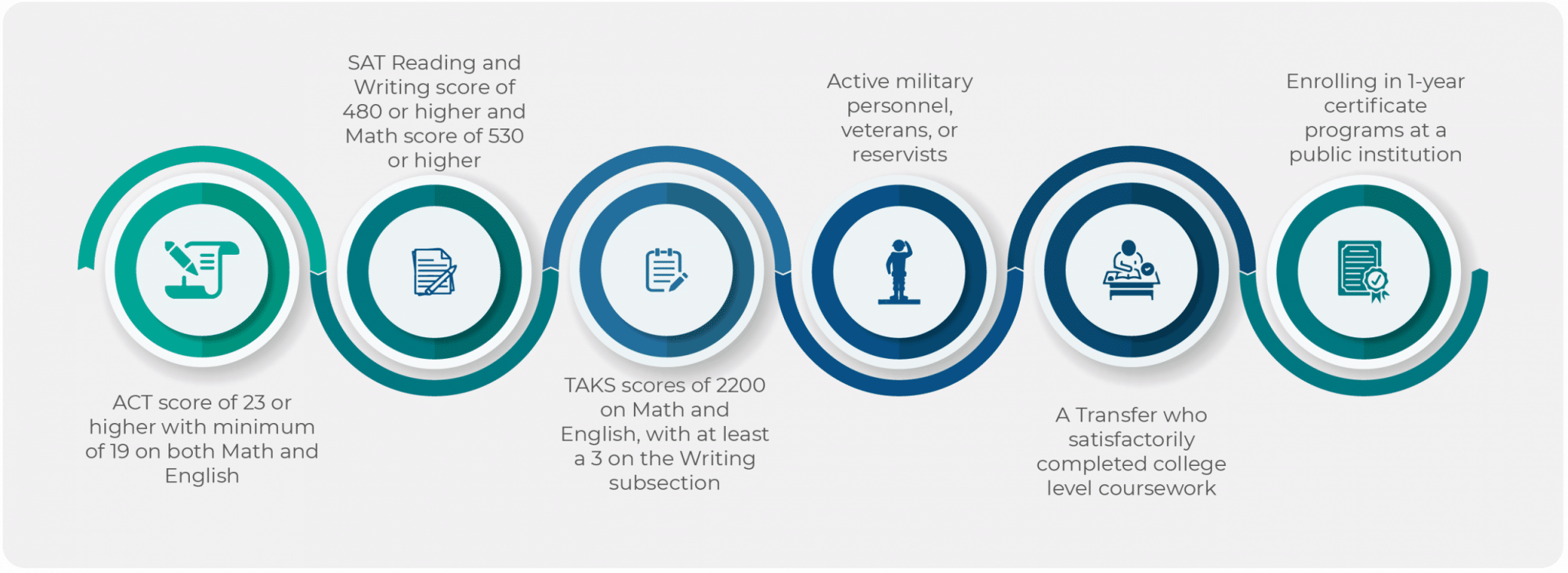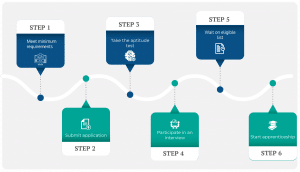
The Texas Success Initiative (TSI) Assessment measures your abilities in math, reading, and writing courses and assesses whether or not you’ll be able to handle college level classes.
If you pass the test, you can register for the entry-level composition, reading, and math classes you want, while other students who failed one or more of the sections will find themselves spending money on developmental classes that cost money but don’t provide college credits toward a degree.
The TSI Test consists of three sections: (1) math, (2) reading, and (3) writing. Passing scores in the three sections range from 340-351, which will allow you to register for college-level classes. Successful candidates have a strong grasp of high school math and English materials. When you pass the test, you’ll graduate faster while spending less money on meaningless courses.
The TSI test contains three sections: reading, writing, and math. It is an untimed test that can be done all at once or spread out over time. Students can also stop in the middle of an assessment, save their progress, and return at a later time to finish the test. For students taking all sections at one time, they can expect it to take between 3-5 hours.
Students take the TSI test at their college or university. Prior to taking the test, students must first take a Pre-Assessment activity (PAA). After they complete the PAA, they receive a pass from their college admissions office to take the TSI test. Students who want to improve their scores may take the TSI test as often as needed. There are a number of exemptions for students, including high scores on ACT and SAT tests, but for those without exemptions, the test is mandatory for Texas college students.
Results scale & interpretations
Frequently asked questions
The TSI test is used by Texas higher educational institutions to determine a student’s correct academic level in math and English. The assessment is divided into three sections, which measures a student’s abilities in the following areas (for complete list, please see Technical Facts section):

In addition, the writing test requires students to write a 5-paragraph persuasive essay.
The test is untimed and taken on a computer. Calculators, dictionaries, mobile phones, or other study guides may not be brought into the test. Each test is different, as it is computer adaptive. Questions get either easier or more difficult based on correct and incorrect answers.
Each test is different, as it is computer adaptive. Questions get either easier or more difficult based on correct and incorrect answers.
Tests are typically administered at a university testing center. However, for out-of-state students or students who live far from their university, the test can often be taken at a local university or testing center.
The test includes a “save and finish later” option, which can be used during any section with the exception of the essay section. The test must be completed within 13 calendar days.

Each section of the test contains approximately 20 multiple-choice questions, based on four different categories. In addition, test takers must write an essay.
While the TSI assessment is not timed, typically it requires an average of three to five hours to complete all three sections of the test.

The three sections and their categories on the test are:

The essay challenges test takers to write the following:
The test is taken on a computer monitor in a university or other testing center. Scratch paper is available for students to use, but they are not permitted to have any additional resources.
TSI tests cost $10 per section. Students who are eligible for Pell Grants can request a waiver. Payment is valid for 6 months from the date of purchase. Students should only purchase the sections that they wish to take.
TSI tests cost $10 per section. Students who are eligible for Pell Grants can request a waiver. Students may retake the test as needed.
Students may retake the test as needed, but it is recommended that they take a course or make time for additional study.
Before students can take the TSI test, they need to participate in a Pre-Assessment Activity (PAA). Each school’s PAA is different, but they all include the following:

There are a number of reasons why a student would be exempt from taking the TSI test. These include:
Download Your Copy of the TSI Test PDF

Students receive results via email on the day they take the test.
Each test section is scored on a slightly different scale. Students are considered college-ready if they can achieve the following scores on the different sections:
Math – Score between 350-390
Reading – Score between 351-390
Writing – Score between 340-390 on multiple choice questions with a 4 or higher on the essay, OR score 310-339 in multiple choice questions, receive a 4, 5, or 6 on the ABE diagnostic section, and a 5 or higher on the essay.
| Score | Holistic Score Description |
|---|---|
| 8 | The essay demonstrates clear and consistent mastery of on-demand essay writing. |
| 7 | The essay demonstrates consistent mastery of on-demand essay writing. |
| 6 | The essay demonstrates reasonably consistent mastery of on-demand essay writing. |
| 5 | The essay demonstrates adequate mastery of on-demand essay writing. |
| 4 | The essay demonstrates developing mastery of on-demand essay writing. |
| 3 | The essay demonstrates little mastery of on-demand essay writing. |
| 2 | The essay demonstrates very little mastery of on-demand essay writing. |
| 1 | The essay demonstrates no mastery of on-demand essay writing. |
Students who are unable to achieve these scores are directed to taking either the DE or ABE diagnostic test. These tests point out the areas where the student struggles and is useful in determining which developmental courses the student should take.
iPREP: Concise. Focused. What you need.